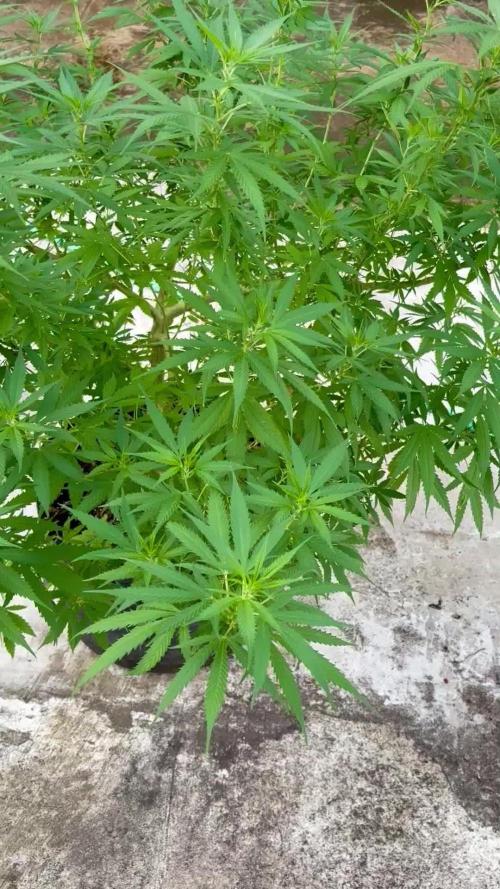The Grow Awards 2026 🏆 





























Likes
Comments
Share


@hash_thetics710
Follow
Last little watering for another week or less
Then we pullllllllllllll :)
Small foliage cut here again … all big fan leaves trimmed just about.
Likes
8
Share


@organically
Follow
Keep on growing anywhere, anytime.
I just love the kind f how they grow.
BTW. this is my first potless Outdoor project.
-
Greetings your organically
» tried and true, since simple is the best!
Likes
9
Share


@Drtomb
Follow
Still doing some. Slight trimming and wwe are on to the races. These girls will begin to stack on weight going forward.
Gorilla zkittlez is a big cultivator
Likes
5
Share


@CreoWeed
Follow
Hey guys,
The week went pretty smoothly and flowers are starting building up.
I'll soon introduce Bloombastic for 10 days, increasing from 0.5 to 1.5 ml per liter.
Other than that, this phenotype are bringing out some gorgeous color, and they are starting to smell.
Now she's finally alone in the tent so I hope she will build up a little more.
For now, thats all lads.
Stay tuned, stay high!
Likes
18
Share


@Khalmenace
Follow
Start of week 9. Buds are filling out nicely, but trichomes are still mostly clear. Breeder says 8-10 weeks so im hoping they are ready in the next week. Both are starting to show a little bit of the leaves fading, not sure if its normal or the start of some sort of deficiency. Super strong smell on both phenos. I was expecting alot more in terms of weight but the quality dies look great. Cant wait! 💨💨
Likes
44
Share


@Prototype0181
Follow
The lady's are a bit shocked after the ✂️ decapitation (topping) on 10-05. going for 6/8 cola's per plant👌
Stay tuned growmies 💚
Likes
7
Share


@Organic473
Follow
I am awaiting her soil to dry out and I will be transferring her to the 25 gallon pot. She is ready for flowering.
Likes
4
Share


@knnabisgrower
Follow
En la tercera semana hicimos un nuevo trasplante, esta vez a una maceta de 4 litros.
Likes
5
Share


@Krissci
Follow
Finally chopped week 10...
Flushed for 10 days....
Early/fast grower.... Strong scents and large buds
Growing this strain again.... Really happy with overall ease of growth.
I expect the taste to be just as strong
Likes
1
Share


@nonick123
Follow
🚀 4 clones de Blueberry Pie F1 Fast seleccionados por @stacksfarmsltd - https://www.instagram.com/stacksfarmsltd
🚀 Breeding by @seedsmangenetics - https://www.seedsman.com/eu-en/blueberry-pie-f1-fast-feminised-seeds-sman-blpi-fast-fem
💦 BioTabs 15% DISCOUNT code "GDBT420" biotabs.nl/en/shop/ @biotabs_official
🌱Substrate PRO-MIX HP BACILLUS + MYCORRHIZAE @promixmitch @promixgrowers_unfiltered
💡2 x Mars Hydro FC1500 EVO Led Grow Light (2024 NEW FC 1500-EVO Samsung LM301H 150W LED) - https://marshydro.eu/products/fc1500-evo-led-grow-lights/ - https://www.amazon.de/dp/B0CSSGN5D8?ref=myi_title_dp
Likes
5
Share


@killerjoint
Follow
10-8-2024 TOP DRESSING AND WORM TEA.....
NOTHING MORE
10-9-2024 22ND DAYS INTO FLOWERING
SMELLS CRAZY ON THESE STRAIN
GETTING SOME SNOW ON TOP
LET'S GO
10-11-2024 DO NOT HAVE ANY PEST BUT JUST IN CASE
NATURESGOODGUYS HOOK ME UP WITH LADYBUGS
JUST GOT HANGING PATCH ABOUT /WITH SHIPPING
10-14-24 NOTHING TO DO...JUST WATER (PH6.6)AND WATCHING THE PLANTS.......
COPY CAT GENETIX STRAINS ARE CRAZY!!!!!!!!
Likes
9
Share


@nEcKk
Follow
The fruits become heavier and begin to ripen.
The night temperature was set to 20° C
The humidity was set to 50%
Likes
5
Share


@Rizza78
Follow
Made it to harvest w 2 so far! Oozecake is a couple extra days. Boy she tastes amazing! Will ice her tomorrow and put her in 48 hrs of dark before I harvest. What an experience it has been! Can’t wait to try after the cure.
Likes
11
Share


@4_Pro2Bono_0
Follow
Week three these ladies only stretched about 1'. Got to see some nice bud development and did alot of plant training. Canopy is filling out nice, no issues thus far.
Likes
31
Share


@Endriu
Follow
Hello Bros&Sis! Ciao!😊
this time I've decided to made a video update, from the start of the week to the finish, we're gonna see some BIG differences! (The longest is from the end)
About the ladies:
Girls in coco
Royal AK- she's drinking every single drop op solution and has literally exploded! I'm really happy about her training (top/lst/hst). A very strong strain.
OG Kush- I don't get this girl, she's definitely not an heavy drinker.
Speedy Chile FF- when I re-potted her into 6lt pot, some of my Bros hoped for a Baobab, what do you think?😂 (has some mutations, has a growth of 3 leaves and then 2 branches have joined together and the other has grown normally)
Ladies in Soil:
UK Cheese auto- I've broke a branch due to heavy crop. Lesson learned.
Pink Doc CBD auto- she's growing good, finally! The only thing I'm worried about is that she will not grow so much, because switch is near.
Candy Kush Express- A really nice lady, not too tall, good side branches and she take everything with no care less (one of the most "broken" in the tent)
Special Kush#1- She likes her new pot, but there's something wrong (see leaves) maybe related to VPD or RU?
I've used different techniques on this ladies, but the one I like the most is cropping the branches and the main stems and also broke the branches where meets the stems, to give'em more power, and more "space" for nutrients transports in sight of bloom!
That's all mate, we will see soon for the next update! Ciao!😙
(hey @Growdiaries if you want to use my video, feel free to do it, but please, don't change the music, it's already on YT and for CC use)
































